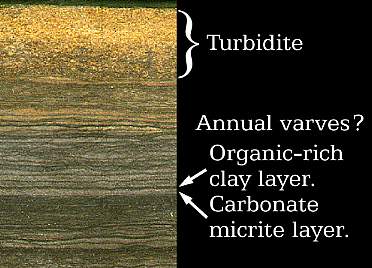Sample Units of Stratigraphic Column
Note change from thick-thin layers at top to microlaminated layers at bottom. The microlaminations are caused by alternating very thin layers of carbonate or micrite, and very thin layers of organic-rich clay. Such alternations form couplets. If these couplets represent seasonal variations in deposition, they are called annual varves. Monsoonal climates are thought to produce varves, because the seasons are so distinct. During the Jurassic Connecticut was under a monsoonal climate. Carbonate micrite layers may have formed during the dry season when evaporation was necessary to cause carbonate to precipitate out of lake waters, while the organic-rich clay layers formed during the rainy season, when bioproductivity and algal blooms would be at their maximum.

Turbidites are in effect underwater landslides. They form from unstable silt and fine sand deposits along steep margins of a lake, which are triggered like an avalanche by vibrations (e.g. earthquakes in active fault zones) to suddenly move to deeper areas of the lake, where they form layers of varying thickness. The Gaillard graben was part of an active fault zone like the San Andreas fault zone in California today. The climate was monsoonal, with a distinct wet season and a harsh dry season, like that of Southern California today.
By counting varves, the duration of the lake can be estimated. However, there is no guarantee that other changes in weather might have caused multiple couplets to form in a year, or no couplets to form. Furthermore, the top part of the stratigraphic column does not contain micrite couplets, which precludes any accurate determination of age. Sedimentation rate can be estimated by the volume of organic-rich clay deposited in the micrite portion, and that rate then can be applied to calculations for the upper non-varved portion. But this method is not as accurate as counting varves.
Also note the significant increase in insoluble inorganic content (i.e. clay/silt) in and above unit 9AB, which corresponds with the disappearance upwards of ferroan dolomite and calcite microlaminae. Correspondingly, total organic carbon (T.O.C.) increases sharply as the volume of annual sedimentation decreased with the loss of carbonate deposition. This change in lake sediment chemistry probably corresponded with a threshold decrease in lake water PH (lake became more acidic). A significant change in fish faunal composition (loss of Redfieldius) also corresponds with this chemical change, as well as a significant increase in the volume of fish recorded in fish-kill layers.
Scan the entire stratigraphic section by scrolling to the bottom of this page (there are links there also). For charts showing relative changes in fish-kill volume through the fresh-water (non-saline) lacustrine sequence, go to the next page.
Below are Acetate Peels of etched rock surfaces, which emphasize the organic and inorganic (non-carbonate) content. Unit numbers (see next page for explanation) are given to the left, while chemical analyses are given to the right for selected layers.
| 1B |
|
|
| 2B |
|
|
| 3B2 |
|
|
| 4AB1 4AB2 |
|
| 4AB3 |
|
|
| 4AB5 | T.O.C. 6.6% Insol. 83% |
|
| 5AB |
|
T.O.C. 5.4% Insol. 57% |
| T.O.C. 6.9% Insol. 74% |
||
| 6AB |
|
|
| 7AB |
|
| 8AB |
|
T.O.C. 4.7% Insol. 50% |
| 9AB |
|
T.O.C. 2.2% Insol. 31% |
| T.O.C. 6.4% Insol. 60% |
||
| 10AB |
|
|
| 11AB |
|
| 12AB |
|
|
| 13AB |
|
T.O.C. 2.9% Insol. 31% |
| 14AB |
|
T.O.C. 3.5% Insol. 36% |
| micrite varves 15AB |
|
T.O.C. 3.3% Insol. 28% FeCalc. 65% 94% as Calc. Fe-Mg 3.4:1 |
| 16AB Diplurus coprolite |
|
T.O.C. 3.3% Insol. 23% |
| 17AB | T.O.C. 2.9% Insol. 23% |
|
| 19AB |
|
T.O.C. 2.6% Insol. 28% FeCalc. 64% 86% as Calc. Fe-Mg 2.8:1 |
| 19AB
20AB |
|
|
| micrite varves 21AB |
 |
Copyright B. Cornet 1999